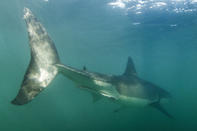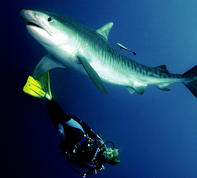Be Dominant
A 4 m long, striped torpedo makes a beeline for my legs. I try to keep calm, to keep eye contact, to be dominant. So far the sharks have veered off before contact, but this time its approach looks for real, and it’s coming with intent.

I let out an involuntary scream, then fin frantically upward as the shark passes underneath me. My guide aggressively wags his finger in my direction: ‘No, no, no’, the digit says. Then he thumps a fist into his open palm and I once again recall the briefing: ‘be aggressive, if it comes too close push it away with your fist or camera.
But NEVER back off, use rapid movements or in anyway act like prey.’ I know the rules; I know exactly what he’s telling me. But man, when a massive tiger shark looks like it’s about to take your legs off, it’s damn easy to lose your cool. I’m scared. If you thought shark cage diving with Great Whites was extreme, you should try this for size.
Our shark dive adventure follows the same principles: baiting in, then diving with sharks, but we do it without the cage. And sharing the waters with us here along the KwaZulu-Natal coast is the indiscriminate, scavenging tiger shark, one of the most dangerous beasts in the world. We’ve done our homework and know full well that the tiger’s undifferentiated, opportunistic feeding habits make underwater encounters with this animal a serious threat.
SCUBA divers, spear fishermen, surfers and boats have been attacked, and there are cases reported where a single individual attacked several people. This is very unusual when considering shark attacks in general, and not the type of information that fills you with confidence before a dive.
Awesome Footage

After the usual exhilarating launch off the beach at Umkomaas, we’re headed to ‘Eel-Skin’, a favourite tiger hangout in the area. The bait bucket, filled with sardines, is lowered into the water and we commence the vigil, trying to calm our jangling nerves.
The first action comes within 20 minutes - dark shapes moving a metre below us, the distinctive stripes of the tiger. Then a sinister, triangular fin breaks the surface. A Great White, unusual in these waters. Our dive guide can barely control himself and immediately starts kitting up.
We are a touch more apprehensive: “What happens if you get in the water with a Great White?”, asks my dive buddy somewhat nervously. “You get the most awesome footage”, comes the reply, deftly dodging our question.
We wait, as three tiger sharks - a female called Scarface and two youngsters - sniff the bait. About 40 smaller black-tips join the party. It’s time to jump in. We do our final buddy checks, grab our cameras and slide in as quietly as our adrenaline-pumped bodies allow. Apparently, there’s nothing like a thumping heart to catch a shark’s attention - but hey, we’re all calm and relaxed around here. There’s no going back now, the buoy supporting the bucket is released from the boat and current carries us further into the open ocean. Initially the sharks circle at a distance, checking us out and avoiding the bait. The circles get smaller until they’re making passes between and below us; curious and, with the exception of the occasional buzz by the black-tips, non-threatening.
I had been warned ‘the sharks will love your bright fins’, but with typical landlubber’s bravado I’d ignored the option to dress down. Now I’m regretting that decision; Scarface is on a mission and my legs seem to fascinate her. My buddy and I are back to back - this seems the easiest way of watching each other’s backs as well as, we hope, presenting a target that’s more than a quick mouthful.
In truth we’re bricking it, but as we relax so do the sharks, until we languidly drift in the company of these fascinating creatures. After 55 minutes, I’m down to 50 bar and have shot off the film in both my cameras. As we ascend to the waiting boat Scarface makes a final pass, and the surge of adrenalin just about rockets me out of the water. Some of the ocean’s apex predators have shared their territory with us, and in my book that rates as an immense privilege.